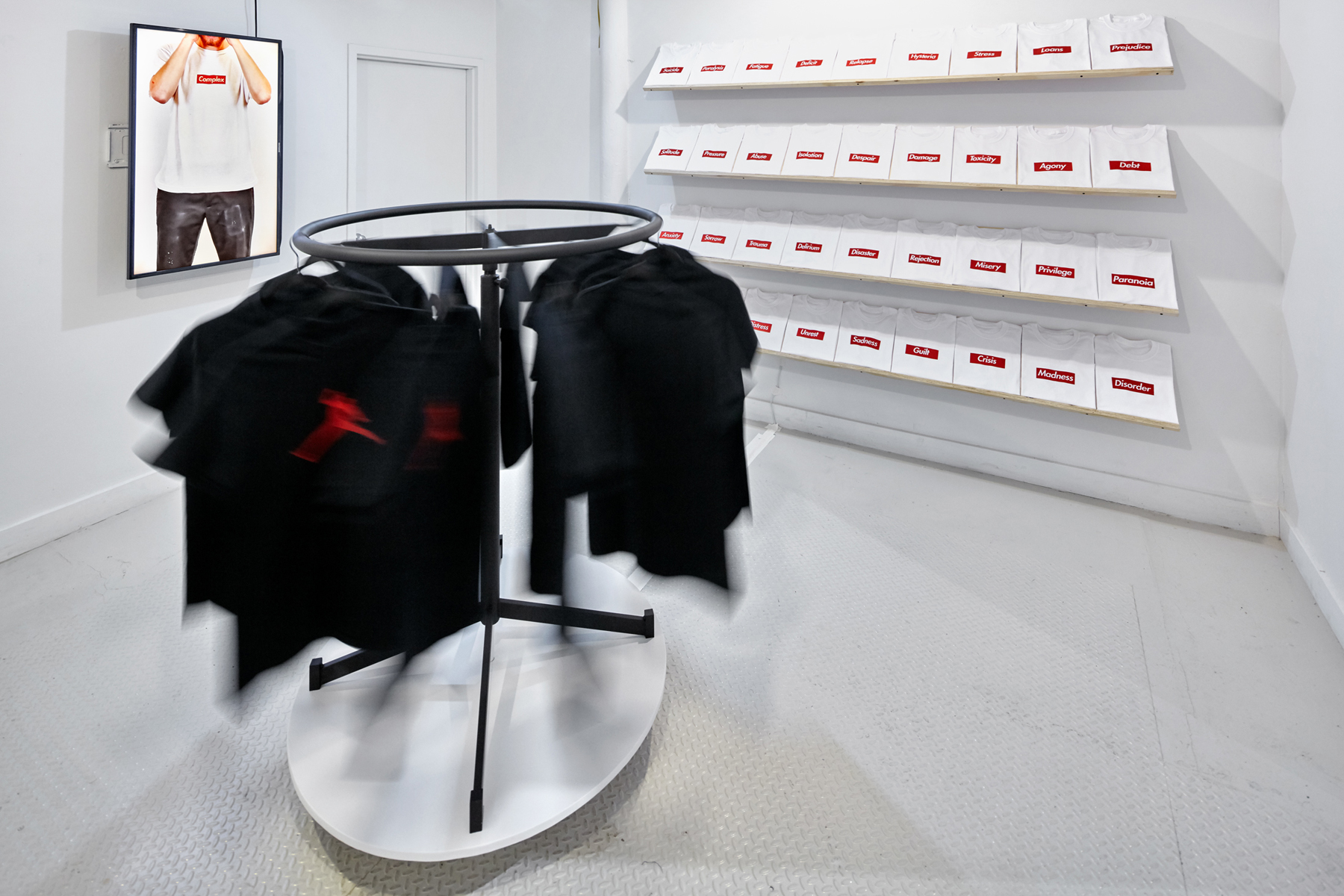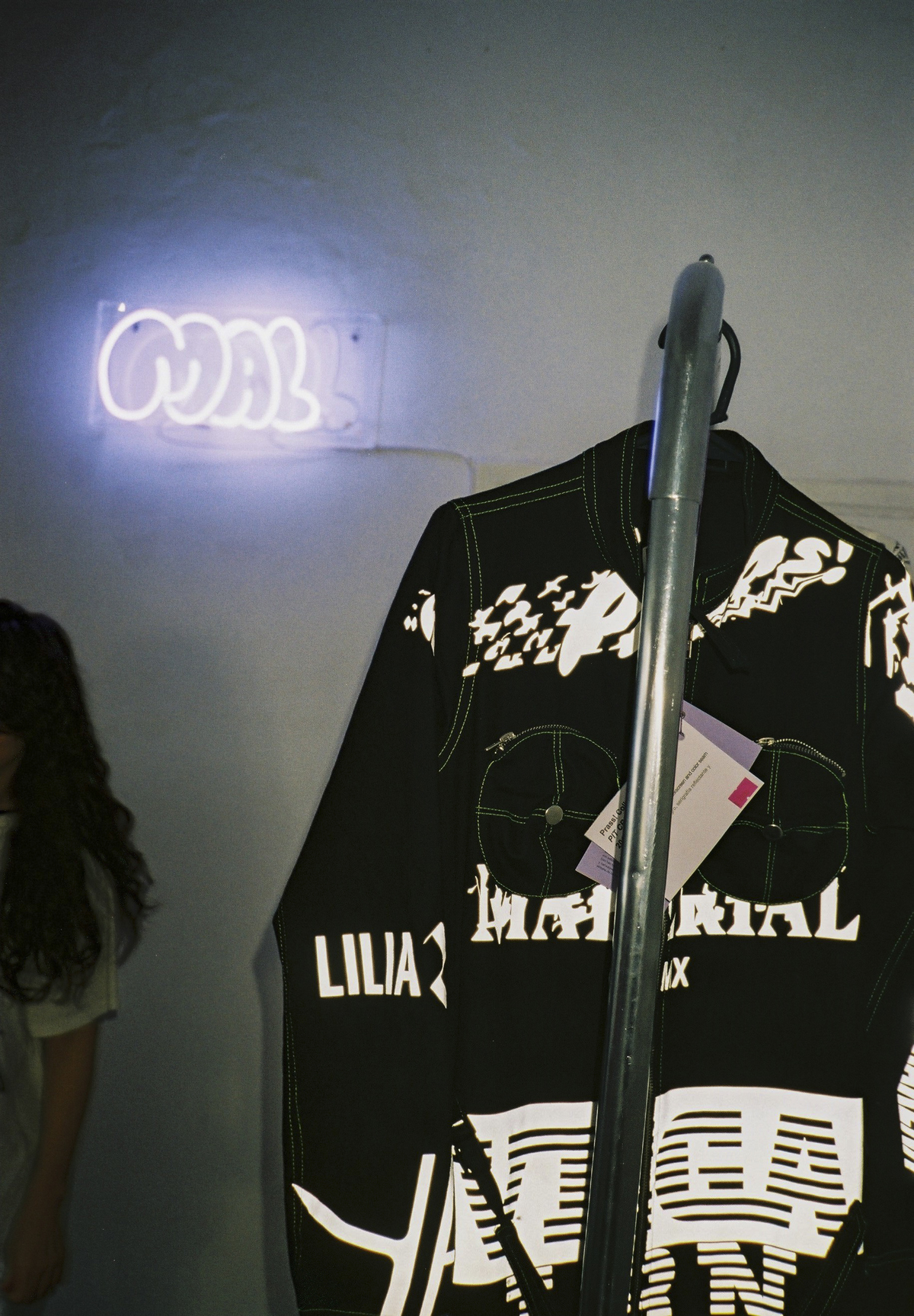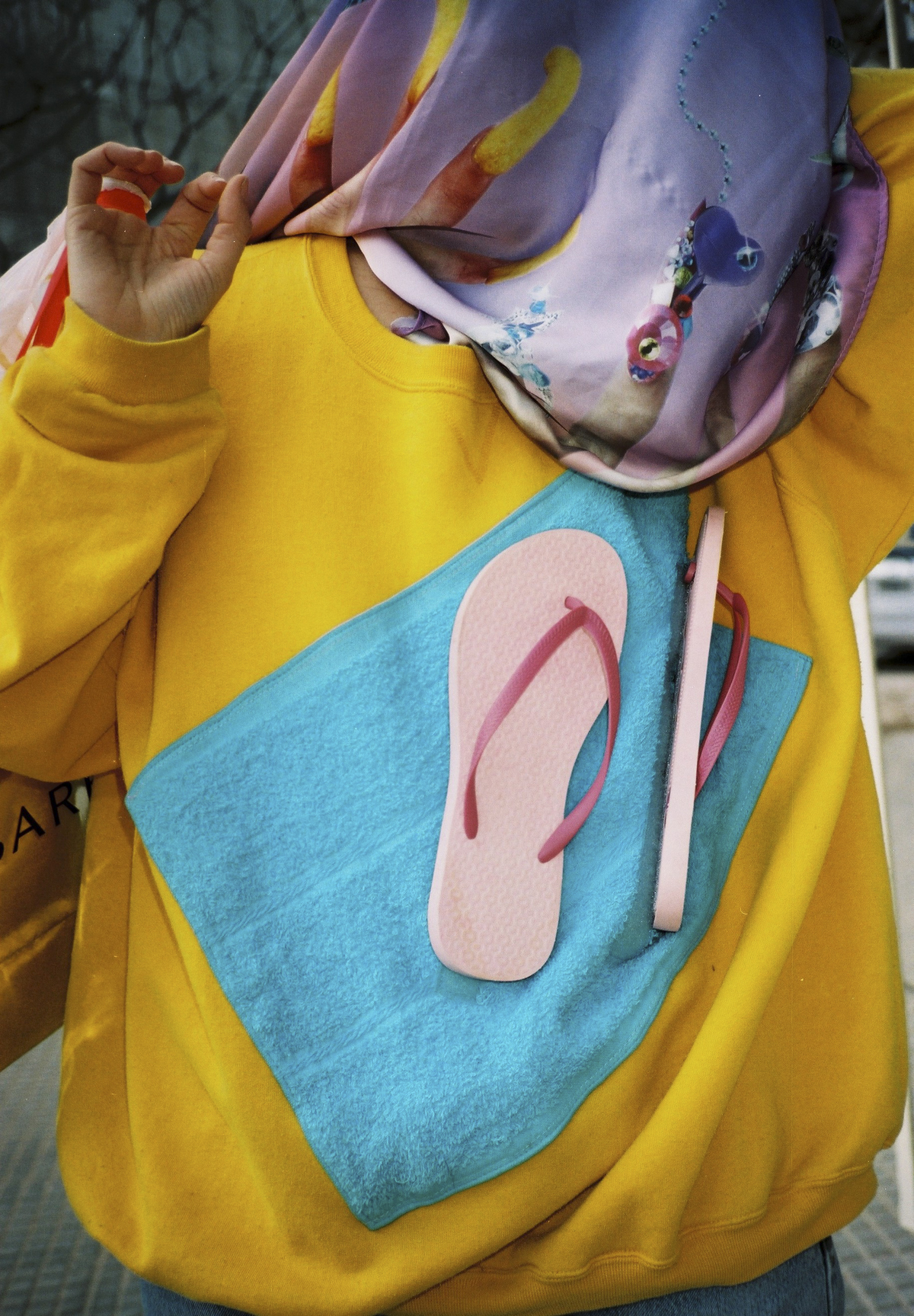Considering the fact that Latin America is the region with the most commercial centers in the world, curator Gaby Cepeda reflects on «MALL», a project created by artist Adriana Martínez and cultural manager Juliana Echavarría dedicated to «wearables», as a means of questioning the relationship between art and consumption in the «post-normcore» era.

«Money, this, that, the other»[1]
In a 2017 article,[2] Madeleine Wattenbarger began her account of the mall boom in Latin America by noting the irreversible decline into which these fortresses of consumerism have fallen in the United States. In contrast, in 2015 the Latin American subcontinent was home to 1,800 commercial centers, with 2,387 more slated for construction by 2025. Wattenbarger traces a line between the mall’s predominance in this part of the world and the effects of the globalization and privatization of public space, both of which are also closely associated with a middle class with globalized consumer habits, whose identity is tied to the above mentioned commercial centers.
If these patterns of consumption remain accurate, as the numbers indicate they have—Mexico has the highest number of commercial centers and of square meters of commercial space per capita on the subcontinent[3]—the last years of the decade have also witnessed the birth of new forms of consumption tied to social media and the gospel of productivity.
The end of the golden age of neoliberalism—the pre-Brexit Obama era, before the sad decline of the Pink Tide—brought us normcore, the trend of sporting anodyne clothing and accessories, void of any reference—outfits that fell somewhere between the wardrobe for cast of Seinfeld, the uniforms worn by members of Heaven’s Gate, and the recent homogeneous religious-capitalist fantasy evoked in Kanye West’s clothing lines. According to Darcie Wilder, the era we are living in today is a sort of nebulous post-normcore moment, one that seeks to reconcile “consumerism, individualism, and populism.”[4] In this epoch, it doesn’t suffice just to consume, to go strolling through a mall, letting the traditional brands on offer delimit the scope of what you can or cannot buy to sate your thirst to spend. No, in this age of almost nonstop political and environmental crisis, you have to be an Informed Consumer—one who knows about the terrible conditions in which the workers who produce fast fashion are forced to toil, about Zara’s sequins and viscose, about the maquiladoras that exploit the working class in developing countries in order to produce our Nike sneakers and Levi’s jeans.
The Informed Consumer nourishes their identity through conscious spending. Organic, fair-trade food, every product ever advertised on podcasts: the last mattress you’ll ever need; the suitcase whose wheels will never break; toothbrushes made of bamboo; reusable water bottles made of aluminum. Buying things like this feels good. The problem is that, little by little, every existing product is sold to us under an ambiguous mantle of ethics and morality: buying this is better than buying that. The reality is that ideally you wouldn’t buy what you don’t need.

And this is where MALL comes in. Also known as MALL en Miami, it is a project created by artist Adriana Martínez and cultural manager Juliana Echavarría in 2018. Located in Nuevo Miami, a space for showing contemporary art in Bogota, MALL established itself as an alternative exhibition space dedicated to “wearables,” works of art that are functionally indistinguishable from clothing and accessories. The interest that propels this project arose out of Martínez and Echavarría’s observation that many of their peers—Felipe Villamil, Juan Obando, and Manuela Besada Lombana, among others—had a tendency to work with clothing in their art practices. Martínez and Echavarría elaborated in a conversation: “It was clear to us that there were several projects in our immediate milieu in which the languages of art and fashion were intermixing formally and conceptually, so we decided to open a space where we could further explore this connection.”

MALL’s first exhibition, in October of 2018, was Cluster, a collaboration between artist Felipe Villamil and designer Olga Piedrahita. For the show, they produced 12 pairs of overalls made of Velcro and fabric which the public was invited to wear. The idea was to create an interactive sound sculpture. The piece, which was also presented at the Museo Tamayo and the Lagos residency space in Mexico City, proposed the tangling of human bodies into a cluster or a bunch, “an improvised choreography” activated by the constant rubbing together of overalls and bodies.
What it is that is implied when we articulate critiques about the status quo of art at the same time that we advocate consumerism?
MALL’s business model is interesting because it promotes inter-Latin cooperation and collaboration by activating people in different countries across the region in order to produce and transport the works on sale. For its presentations in Mexico City, MALL coordinated the movement of 1,200 pieces across the Americas in the suitcases of people traveling on 19 different flights, covering 8,910 kilometers. Arriving in Mexico City in February 2019 for art fair week, MALL set up in two different franchise locations: one in the Museo Tamayo’s gift shop and the other in Lagos. These franchises functioned as they would for Forever 21 if it were an art gallery. The difference between fast-fashion chains and MALL however is that MALL shares its “knowledge, procedures, intellectual property, commercial model, and brand so that others can exhibit and sell their own products and services,” while the space soliciting the franchise is expected to provide standard display structures: hangers, clothing racks, and plastic bags bearing the MALL logo. They must also produce a neon logo, each franchise designated with its own color: Good to Know space in Miami with yellow; UV Estudios in Buenos Aires with purple; Espacio KB in Bogota with orange; Museo Tamayo with red; and Lagos with light blue. Each franchise deals the products MALL offers, dividing sales so that the artist receives 50 percent of the profits, while the host space and MALL take 25 percent each. Additionally, objects produced by artists in their areas of influence may also be integrated into the displays—as with the work of Radamés “Juni” Figueroa of Puerto Rico, Maruki Nowacki of Argentina, Chloé Wilcox of the United States, the Koumori brothers of Mexico, Oni 88 of Chile, and Ruda of Venezuela.
Beyond its business model, MALL’s objective is to expand “the forms of dissemination of art,” to allow artwork-clothing to become “alternative vehicles of information and knowledge” that will serve to attract that mythical new audience—those who live and work outside of art institutions and galleries. In a quasimodernist gesture, MALL aims to make art “a vital part of everyday life,” just as fashion clearly is. In a text cheekily titled Education as Commerce, written by Ian Solaski, an artist from the US and creator of the brand Bleshüe, and published in the MALL magazine, a graphic tee is described as a “symbol and [a] tool,” a transcendent object in contemporary life, loaded with the potential to “involve, interrupt, educate, and mobilize […] cutting across all social class.” For Solaski and for MALL, artwork-clothing has the ability to circulate ideas among an older social demographic than can reach the more established tentacles of art, relaying stories and engendering a new form of collecting—that of the closet. But above all, these pieces can stimulate conversations and arguments. Yet MALL, despite being “critical of the established order”—of the rigidity of the status quo of the art world— positions itself only in spaces dedicated to this established order: museums, galleries, and independent spaces. This is because they want their client-collectors, the buyers, to be “agents capable of having conversations, of being mobile exhibitions, tour guides of their own bodies.”

They must not be mere mortals looking for the cool new T-shirt or logo. They must be instructors, missionaries of the importance and relevance of contemporary art’s infiltration into the everyday lives of civilians. They are the Informed Consumer.
Like almost all art spaces, with their nervous flirtations with both elitism and populism, MALL is an exercise in contradictions. On the one hand, it considers itself to be an expanding gesture, the idea being that one buys the artwork-clothing and by wearing it—or perhaps even showing it off—generates conversations outside the prevailing endogamy of the art world. Maybe you buy a Bleshüe T-shirt bearing an image of Joseph Beuys torturing a coyote in New York, and your neighbor or, better yet, your uncle scolds you, “What on earth is on that T-shirt?” And this is the Informed Consumer’s time to shine, their opportunity to recite highlights from Joseph Beuys’s Wikipedia page or, even better, to propose their own ideas about the work of a famous artist. Perhaps your neighbor or uncle finds it interesting and suddenly throws themselves into the study of contemporary art with newfound appreciation, but more likely their eyes will glaze over with boredom.
It is here that I think MALL could play a powerful role: in proposing other forms of exchange based on the materiality of art, ones in which not only objects foster dialogues but so do other forms of exchanging knowledge that exist outside the logic of consumption.
Although the collaborative effort and exchange MALL promotes between young artists from different regions in Latin America is laudable and necessary work, it is nonetheless essential that we ask ourselves what it means that such efforts are mobilized in the name of consumption. What happens when conversations about art led by artists are grounded in the consumption of objects, in the creation of more efficient commodities? In making objects-works-clothing that are more easily consumed, more portable, more wearable, until, in the words of Martínez and Echavarría, they become like cigarettes, “bought in the moment and serving the same purpose for everyone.”
Above all, we must ask ourselves what it is that is implied when we articulate critiques about the status quo of art at the same time that we advocate consumerism? That we adopt the very forms of socialization that promote capitalism; that in order to have a conversation about art we have to buy and wear a T-shirt with Beuys on it or socks branded with the name Wittgenstein instead of Wilson? Why promote—like the commercial center that appropriates public space and investment for its transnational franchise deals—social relations mediated by consumerism?

In addition to the above, reviewing MALL within the framework of this issue of Terremoto is also an opportunity to pause for a moment in the economic irony that organizes the current system of contemporary art. It is curious—although probably not an accident—that the vast majority of those of us who support ourselves on work in museums, galleries, independent spaces, schools, foundations, communications, artist studios, et cetera, do not have the means to buy art according to the hegemonic commercial logic of such spaces, and it is worth imagining what our trade would look like if it were we who boasted some of that power. In the case of MALL, although it offers objects-works-clothing at an overall more accessible price than a traditional painting or sculpture would be, in light of the current salaries and income of the workforce that upholds the system of contemporary art—at least in Mexico and Argentina (to mention two of the countries where MALL has had events)— participation in the model that Martínez and Echavarría propose remains exclusively available to only a certain social class within the art world. This brings us to a necessary conversation about the value of art in relation to salaries, production costs, and dynamics of commercial circulation within the framework of our basic needs for survival. It is here that I think MALL could play a powerful role: in proposing other forms of exchange based on the materiality of art, ones in which not only objects foster dialogues but so do other forms of exchanging knowledge that exist outside the logic of consumption.
In the end, as the current crisis that engulfs us all has demonstrated, critiques and pseudo-activism proposed from the perspective of consumption—Kendall Jenner giving a Pepsi to a policeman to dispel tension at a protest, for example, or wearing T-shirts that proclaim “The Future is Female” to support Hillary—simply don’t work, and beyond that, can even be dangerous. Not too long ago, at the beginning of the decade that recently came to a close, similar discussions arose around post-Internet art. A term originally coined by Marisa Olsen and Gene McHugh to describe art in the age “after the Internet”[5]—when the World Wide Web became an ordinary phenomenon, just another tool for paying your bills and chatting with your grandmother—it was quickly adopted by the commercial sector of the art world to signify a kind of production that, in contrast to Digital Art or Net Art, was geared towards the production of objects, so that young and not-so-young galleries were suddenly flooded with readymades that materialized a very specific Tumblr aesthetic popular in those years into real life: LED screens on the floor, Axe deodorants run through with katanas, office chairs and display furniture made of steel and tempered glass, corporate slogans and branding. But above all, it referred to an ethics of artistic practice that Brad Troemel described as the “athletic aesthetic,” in which “art making becomes a fast-paced, high-volume endeavor analogous to the universe of automated high-frequency stock trading.”[6] For Troemel, artists were not even CEOs, rather they were the merchandise itself, selling their products/artworks and themselves and flooding social networks with content as quickly as possible. The label “Post-Internet Art” quickly garnered many critics for becoming synonymous not only with a corporate aesthetic but also with the exploitative logic of capital: artist (here, singular male) as entrepreneur/ businessman/merchandise. What was initially thought of as a viable way of monetizing Net Art’s immaterial production—transferring it to the world of objects and galleries—eventually became a cynical exercise from which many artists quickly dissociated themselves.

In a certain way, these concerns preceded those of Marina Vishmidt, who warns that artistic speculation and its proximity to the financial speculation of capital functions as “a biopolitical mechanism for the production of subjects who identify with capital immanently, rather than ideologically”[7]—a logic that for her corresponds to a kind of primitive accumulation that subsumes everything that surrounds us into specific forms of value that are in turn always commodifiable:[8] art, education, social and affective relations—everything is consumable. Given this reality, if we continue to allow the logic of consumption to pass for critical acts, and if we refuse to dispense with structures of trade and capital in our social relationships, and worse still, if we don’t succeed in imagining an alternative to this situation, we cannot realistically expect new, more just, less elitist horizons to materialize in the art world or beyond.
As Darcie Wilder puts it, “Maybe, in the end, we’re just tired and want to wear a plain T-shirt we don’t have to talk about, and maybe no one else even cares what T-shirt we wear at all.”[9]







Comments
There are no coments available.